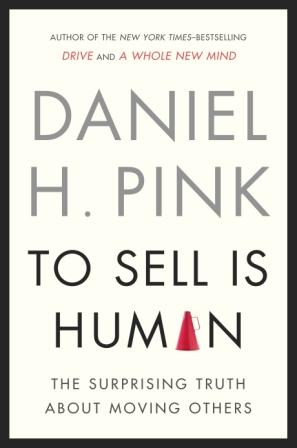Jun 4, 2013
 Recently, bestselling author Daniel H. Pink took some time out of his wildly crazy schedule to answer GLP’s burning questions about his compelling new book To Sell is Human: The Surprising Truth about Moving Others. Why should you care about sales? You’d be surprised . . . read on!
Recently, bestselling author Daniel H. Pink took some time out of his wildly crazy schedule to answer GLP’s burning questions about his compelling new book To Sell is Human: The Surprising Truth about Moving Others. Why should you care about sales? You’d be surprised . . . read on!
GLP: Your book – To Sell is Human – is all about sales. Our community is filled with trainers and consultants who think “sales” is conducted by the world’s used-car salespeople, not by trainers and consultants. Why should they care about sales?
Dan: Well, like it or not, they’re in sales, too. If they’re independent trainers and consultants, they’re selling their services all the time. If they’re in-house, they’re selling in a broader sense. That is, they’re spending an enormous about of their time, persuading, influencing, and convincing others to make an exchange. They’re trying to get the boss to free up resources, their colleagues to do different things in different ways, and so on. We have survey research showing that American workers are spending about 40 percent of their time on the job — 24 minutes of every hour — in what I call “non-sales selling.”
It’s understandable that some people in your community might not like that idea. Lots of folks think of sales as sleazy, cheesy, and slimy. But that view is outdated. Selling has a bad rap because most of what we know about it arose in a world of information asymmetry — where the seller always had more information than the buyer and therefore could rip off the buyer. But today, information asymmetry is giving way to something at least close to information parity. That’s changed the game in ways we’ve scarcely recognized. We now live in a world not just of “buyer beware” — but also of “seller beware.”
GLP: One tenet central to our Dialogue Education approach to training and development is the power of the open question to ignite learning; in your book you hit upon the power of self-talk and self-questioning, which caught our interest. Tell us more!
Dan: “Interrogative self-talk” was one of the most intriguing ideas I ran across in my research. The conventional view is that before an important pitch meeting or sales call, the smartest move is to pump ourselves up — to tell ourselves, “You can do it.” That’s certainly better than doing nothing. But new research shows it’s not nearly as effective as turning the declaration into a question — and instead asking ourselves, “Can you do it?” The reason is that questions, by their very nature, elicit an active response. So when I ask myself “Can you do it?” I have to answer — and I have to explain how I’m going to do it. In those answers, I rehearse and prepare in a way that’s far more muscular than mere affirmation.

GLP: We’re all familiar with the terms introvert and extrovert. In your book you introduce an intriguing new term—ambivert. What can you tell us about ambiverts?
Dan: We have this notion that some people are “born” salespeople — and, by extension, that certain types of people do it best. Many of us believe that extroverts make the best sales people. But new research from Adam Grant at the University of Pennsylvania’s Wharton School calls that into question. In his research, which I write about here, he found that strong extroverts were only slightly better at sales than strong introverts. Why? Strong extraverts can talk too much and listen too little and overwhelm people with their forceful personalities. The people who did the best — by far — were the “ambiverts,” those in the middle. These folks, who are somewhat introverted and somewhat extroverted, are the most attuned and therefore make the best salespeople. What ought to be heartening is that most of us are neither strong introverts nor strong extroverts. Most of us are ambiverts, which suggests that most of us are reasonably well-positioned to sell effectively.
GLP: We love that your book includes sample cases at the end of each section! Imagine that you were opening the doors to Dan Pink’s One Day School of Business Thought. What are the top three exercises you would share with our trainers to help them increase their sales acumen (without feeling smarmy)?
Dan: To Sell is Human contains about 70 tools, tips, and exercises that build on the social science to give people practical ways to get better at selling. Here are three that might help:
- Pull up a chair. This is a technique used by Jeff Bezos, founder of Amazon.com. In any meeting, he includes an empty chair at the table, to remind those assembled who’s really the most important person in the room: the customer. Your empty chair might be a client, a trainee, or a company executive. Once you get used to including that person in your thinking, you’ll have gone a long way toward understand their thinking.
- Try a question pitch. Questions often pack a surprising punch – In 1980, Ronald Reagan made effective use of a very simple question: “Are you better off now than you were four years ago?” Yet questions are underused when we try to move others, despite a raft of social science that suggests we should deploy them more often. Beginning with research in the 1980s, several scholars have found that questions can outperform statements in persuading others. The reasons for the difference go to the core of how questions operate. When I make a statement, you can receive it passively. When I ask a question, you’re compelled to respond, either aloud if the question is direct or silently if the question is rhetorical. That requires at least a modicum of effort on your part. Can you come up with a great question pitch for your product or idea?
- Ask yourself the two most important questions. At every opportunity you have to move someone, be sure you can answer the two questions at the core of genuine service: (1) If the person you’re selling to agrees to buy, will his or her life improve? and (2) When your interaction is over, will the world be a better place than when you began? If the answer to either of these questions is no, you’re doing something wrong.
*********
Daniel H. Pink is the author of five provocative books– including the long-running New York Times bestsellers, A Whole New Mind and Drive. His latest book, To Sell is Human, is a #1 New York Times business bestseller, a #1 Wall Street Journal business bestseller, and a #1 Washington Post nonfiction bestseller. Dan’s books have been translated into 34 languages.



